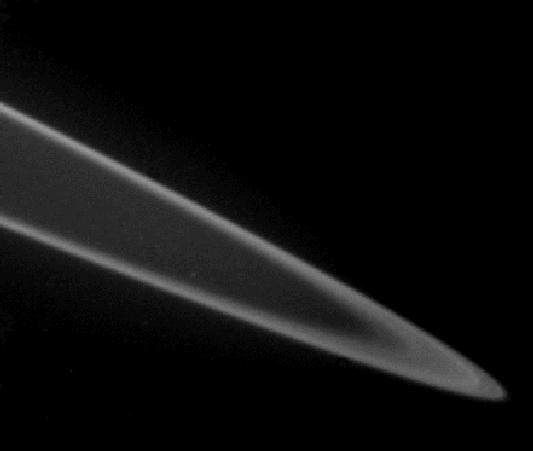|
|
Shedding Some Light On Jupiter
Apr 23, 2009
Jupiter’s rings were unknown
until about thirty years ago. Recent
data analysis from the Galileo
spacecraft reveals electric currents
flowing around the planet, just as
EU theorists predicted.A
recent announcement by scientists from the Jet
Propulsion Laboratory, NASA and the University of Maryland
states that Jupiter’s rings are actually electrically
charged. Douglas Hamilton, a planetary scientist from the
University of Maryland wrote:
"On Jupiter's
day side, the sunlight charges the dust particles
positively, while on the night side the particles carry a
negative charge. Different charges react differently to
Jupiter's magnetic field, leading to changes in particle
orbits, and when conditions are right, even the tilt or
inclinations of the ring particles change.”
Jupiter's rings are formed out of a thin sheet of material
encircling the planet. The ring structure is quite diffuse,
making observations difficult unless they are in correct
alignment with the Sun. The outer radius begins at 129,000
kilometers, almost the same distance as the moon Adrastea.
The four small moons, Metis, Adrastea, Amalthea and Thebe,
are said to influence the structure of Jupiter’s rings in
the same way that the “shepherd moons” of Saturn govern the
shape of its huge ring formation.
More than four years ago Picture of the Day articles
addressed the "volcanic" plumes on Jupiter's moon Io and
demonstrated that they are plasma discharges from the moon
to the gas giant. Some planetary scientists later began to
acknowledge the electrical connection between them when Io's
"footprint" was seen in the polar aurora on Jupiter. In
fact, all four of Jupiter’s largest moons were discovered to
leave their marks in the aurora in the shape of “tails”
flowing within the plasma column. Later, when NASA launched
New Horizons on a mission to study Pluto and Charon, the
“plumes” of Tvashtar, a gigantic volcano on Io, were found
to be filamentary in structure with indications that they
are actually corona arc discharges from the electric “hot
spots” linking the moon with Jupiter.
Astronomers suggested that “tides” on Io from the “kneading”
effect of Jupiter’s gravity cause the charged particles to
be released in the "volcanic" plumes. The particles then
flow as an electric current to Jupiter. Since electricity
does not flow in one direction the one-way connection cannot
be correct, so how is the electricity moving between Io and
Jupiter?
Conventional theories assume that the universe is
electrically neutral, so when observational evidence
confirms electrically active plasma for instance, localized
phenomena no matter how improbable are invoked. Tidal forces
and volcanoes are presented as the cause for the activity
seen on Io and the evidence for electric circuits is
ignored. In the case of Jupiter’s rings, the same thing is
happening. The ring charge is said to be caused by sunlight
and shadow rather than by an electrically active circuit
between Jupiter and the Sun.
Jupiter is connected with the Sun and the Sun is connected
with the Milky Way – and the Milky Way is probably connected
with the Local Group and then with the Cluster and so on and
so on. That idea is what forms the basis of Electric
Universe Theory that all things throughout the cosmos are
composed of electrically quasi-neutral conducting plasma -
extremely diffuse on the large-scale but capable of
transmitting currents powerful enough to energize stars and
the galaxies.
An electrical interaction between Jupiter and its moons
means that they are charged bodies and are not electrically
neutral. Jupiter exists in a dynamic electrical relationship
to the Sun and it is now known that charged particles from
the Sun and not “electric dynamos" power the planetary
aurorae. Just like the aurorae, the ring system on Jupiter
is probably behaving in similar fashion to what is seen on
Saturn, so a similar explanation is most likely correct.
The gas giant planets all have rings in some form or
another. The plasma torus that surrounds each of them and
the electric currents flowing along the polar axes and then
out the equatorial plane are the likely cause for their
persistence. No one knows for sure how planetary ring
systems are formed and maintained, but rather than seeking
the answer in strictly mechanical action electricity and
current flow through dusty plasma will provide more
reasonable explanations.
By Stephen Smith
|
|
|
|
|
|
SPECIAL NOTE - **New Volumes Available:
We are pleased to announce a new
e-book series
THE UNIVERSE ELECTRIC. Available now, the first volume
of this series, titled Big Bang, summarizes the failure of modern cosmology
and offers a new electrical perspective on the cosmos. At
over 200 pages, and
designed for broadest public appeal, it combines spectacular
full-color graphics with lean and readily understandable
text.
**Then second and third volumes in the series are now available,
respectively titled Sun and Comet, they offer
the reader easy to understand explanations of how and why these bodies
exist within an Electric Universe.
High school and college students--and teachers in
numerous fields--will love these books. So will a large
audience of general readers.
Visitors to the Thunderbolts.info site have often
wondered whether they could fully appreciate the Electric
Universe without further formal education. The answer is
given by these exquisitely designed books. Readers from
virtually all backgrounds and education levels will find them
easy to comprehend, from start to finish.
For the Thunderbolts Project, this series is a milestone.
Please see for yourself by checking out the new
Thunderbolts Project website, our leading edge in
reaching new markets globally.
Please visit our
Forum
|
|
|
|
|
|
|
|







